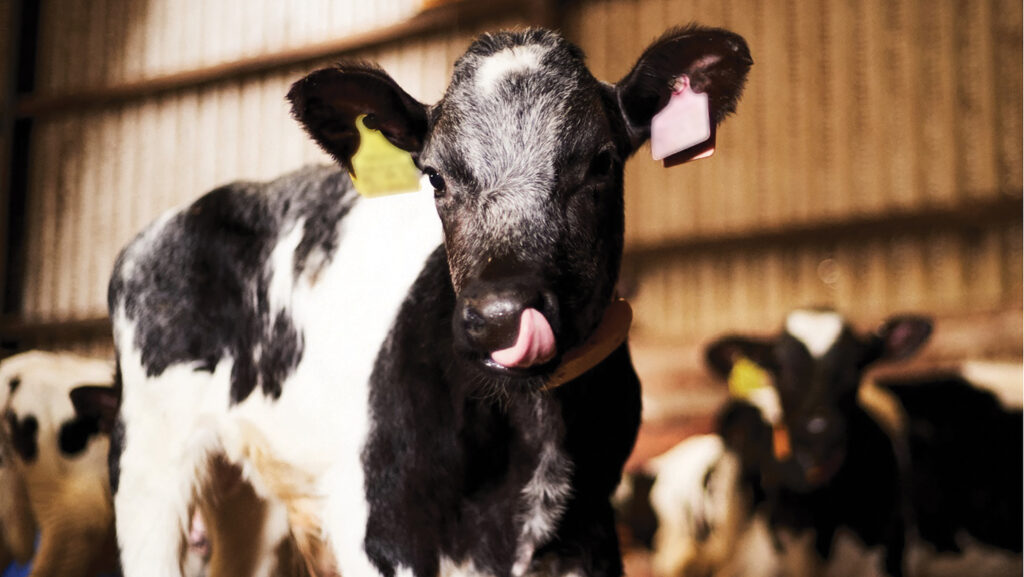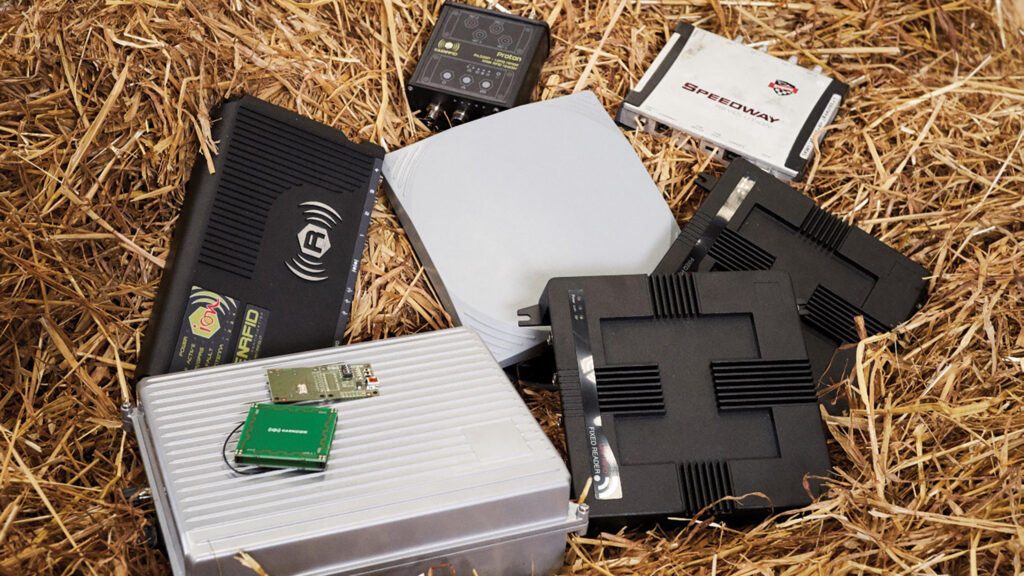Ultra-high or low frequency cattle EID tags: Which is best?
 Blue cross dairy calf with ultra-high frequency tag © ScotEID
Blue cross dairy calf with ultra-high frequency tag © ScotEID A debate is raging about what tag technology should be used in the UK’s national cattle traceability scheme when it eventually arrives.
The stand-off is between the low frequency (LF) tags and ultra-high frequency (UHF) tags, with compelling arguments for both sides.
UHF is newer, safer, faster and capable of carrying more information than LF tags. In short, it’s a better technology. But this may not be enough to oust the established system.
See also: Livestock leaders see ‘real potential benefits’ of cattle EID
All electronic identification (EID) sheep systems sold as standard in the UK have used LF tags since the EU mandate from 31 December 2009.
Some cattle and pig farmers also monitor animal performance with LF systems.
Farmers Weekly spoke to David Kerr from ScotEID, the Scottish government-funded research and development organisation operating Scotland’s livestock traceability system.
ScotEID is impartial, and has installed LF and UHF systems on farms, marts and abattoirs. It says UHF has been proven to work on more than 320 farms.
How do the tags differ?
Low frequency tag
- Operate at 123-134KHz
- Comes in two varieties – full duplex (FDX) and half duplex (HDX)
- Is widely used in animal identification, such as for cats and dogs
- The technology was developed in the UK in 1973
Ultra-high frequency tag
- Operate at 860 to 960MHz
- Common in other sectors of the economy, such as tracking packages in logistics, airport and border security and Amazon warehouses
- Developed by IBM in the 1990s
Is it true that UHF tags aren’t as durable?
Not anymore. This was true six or seven years ago, but any tags that didn’t meet the UK PAS44 standard are now obsolete or superseded.
How do they compare price wise?
UHF tags and readers are slightly cheaper due to wider availability and use in other industries.
Does reading multiple tags simultaneously cause problems at the race?
No. UHF readers are easily adjusted to read at 3m or more, or less than 10cm, when needed.
You can read multiple animals in a second through a 3m passage, or identify one animal to record weight gains or a movement off farm.
Is it true that UHF doesn’t work well around steel?
No, if anything it is the opposite. LF readers struggle to work around steel gates and pens, whereas UHF deflects off metal and reads are actually improved.
Will this mean different kit for cattle and sheep?
Yes. But to mitigate the issues, we have developed dual frequency tags (both LF and UHF).
This brings a higher tag cost, but may help some farms keep the older LF kit usable.
Who makes high frequency technology?
APK and Smartrac both produce UHF tags that are UK PAS44 approved for use in livestock as official identifiers.
Are farms adopting UHF technology?
Farms that have trialled the technology in Scotland (and through NFU work in England) have installed UHF systems on their farms for more accurate tag readability and improvements in user health and safety.
Voluntary uptake in Scotland is more than 180,000 tags on over 320 farms.
What are farmers waiting for?
UHF EID must gain institutional recognition from UK government and EU for traceability purposes.
Acceptance from the International Organisation for Standards (ISO) would help governments mandate the technology, and there is now an ISO encoding standard for UHF.
How the LF and UHF systems compare
Low frequency EID
- Tag cost £2.20
- Reader cost – £300 to £1800 (handheld), £1,500 or more (fixed)
- Read range – 15cm (handheld), 0.5m (fixed)
- Reads one animal at a time (no anti-collision properties)
- Interference risk is high – affected by metal and electronic signals close by
- Security tags are permalocked to protect information
Ultra-high frequency EID
- Tag cost £2.20
- Reader cost – £300 to £1,600 (handheld); £300 to £1,300 (fixed)
- Read range – 2.7-6.6m (can mimic LF’s short reading distance if required)
- Multiple reads at once – 2.2 calves a second with 100% accuracy
- Interference risk is low – reader can be configured to avoid impairments
- Security tags are permalocked to protect information

A selection of fixed ultra-high frequency readers © ScotEID
Thainstone backs UHF
UHF technology has been proven to work in a commercial sale-yard setting, according to staff at one of the UK’s busiest cattle markets.
Aberdeen and Northern Marts’ (ANM) Thainstone site has trialled UHF technology with about 50 farmers for 2.5 years on behalf of ScotEID, reporting 100% accuracy.
ANM special projects manager Isabel Buchan oversaw the trial work, which made the following conclusions:
Infrastructure
A new digital recording system and a cloud-based data capture system was needed for the UHF ear tags. UHF readers were placed in passages and behind the sales ring in the market.
Reads
Cattle were read on and off the market holding and in various locations through the market. Staff noted the potential for paper passports to be replaced with an online ScotEID system
Reliability
Sheep ear tag (LF) readings have a 95% accuracy through the market. The mart is full of steel gates and barriers which interrupt the low frequency signal.
The UHF signal is amplified by the metal and was 100% accurate, and not affected by LF signal.
Speed
Cattle tags can be read as they run through a passage. A whole wagon load of cattle can be read in a few seconds. Time is saved on putting them down a race to be individually read
Isabel says that efficiency gains were huge, but the biggest win is in health and safety.
She added: “The group took on the project because it is a co-operative, and assessing the technology was seen as a good thing for the livestock sector.
“UHF technology avoids drovers having to get close to stock to manually read tags because of cattle with hairy ears and mucky tags.”
What does the industry say about UHF vs LF?
Approved Livestock Identification Manufacturers’ Association
“LF tags are underpinned by 12 international standards that control everything from coding of the chip on an electronic tag, to how that data is transferred and interpreted by a reader, and then into farm management software and/or government databases.
“Comparable standards do not yet exist for UHF, but are in development.
“Farmers should also be aware that current on-farm LF reading equipment – such as stick/wand, handheld and panel readers – will not work with UHF tags.”
NFU chief livestock adviser John Royle
“After trial work on farms, the NFU fully supports the adoption of UHF tags, and will lobby Defra for mandated dual-frequency tags so the livestock sector can benefit from the improved accuracy, reliability, reading range and capacity of UHF technology.
“Issues need to be resolved, but progress is needed after too many delays.”
Matt Blyth of Blyth Livestock Advisory Services
After recently penning a Nuffield scholarship on the topic, Matt Blyth said: “UHF has a lot of potential. It’s essential that we have a system that works across all species and UK nations.
“Whatever we put in place, we need training and education on how to use it.”
Farmer consultation
Farmers can respond to the cattle identification and traceability consultation online. The consultation closes on 27 June 2024.
